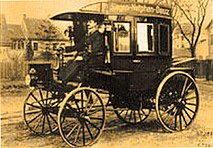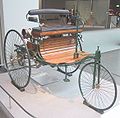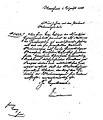कार्ल बेन्ज
थ्व पौयात उल्था याये ल्यं दनि

कार्ल फ्रायडरिच बेन्ज (नोभेम्बर २६ ई सं १८४४ – अप्रिल ४ ई सं १९२९) छम्ह जर्मन इञ्जिन डिजाइनर व अटोमोबाइल इञ्जिनियर ख। वय्कःयात ग्यासोलिनं सनिगु अटोमोबाइलया आविष्कारक धका म्हसीकिगु या।
सन् १८८५स बेञ्जं हलिंया दकलय् न्हापांगु कमर्सियल अतोमोबाइल "मोतरव्यागन" (Motorwagen) दयेकादील। थ्व गसाः इन्तर्नल कम्बस्चन इञ्जिन छ्येला सनिगु या। थ्व गसालय् स्वचाः घःचाः दयाच्वन। न्ह्यःनेया घःचालं निर्देश याइगु व गःसालय् गइपिं यात्रु व इञ्जिनयात ल्युनेया निचाः घःचाया च्वे तयाः दयेकूगु थ्व मोदेलयात त्राइ-कार (Tri-Car) धका नं म्हसीकिगु या। बेञ्जजुं दयेकादीगु कारया मेमेगु कुचालय् कार्बोरेतर, एसेलेरेतर, ब्यात्रिया स्पार्कं सनिगु इग्निसन व्यवस्था, स्पार्क प्लग, क्लच, गियर शिफ्त, व लः छ्येलीगु रेदियतर आदि ला।
सन् १८९६स कार्ल बेञ्जं हलिंया दकलय् न्हापांगु इन्तर्नल कम्बस्चन "बक्सर इञ्जिन"या दिजाइन व प्यातेन्त यानादिल। थ्व इञ्जिनस अःखलं दूगु पिस्तन दयाच्वन। थ्व दिजाइन सिद्धान्त आःया इलय् तक मोतरकासाय् ब्वति काइगु तःच्वलं ब्वाकीगु इञ्जिनय् छ्येलीगु या।
भाजु बेञ्जं बेञ्ज कम्पनि पलिस्था यानादिल। थ्व कम्पनिं लिपा दायम्लर बेञ्ज, मर्सिदिल बेञ्ज व दायम्लर क्राइस्लर कम्पनि बुयावल। मदयेस्वया न्ह्यः वय्कलं, वय्कःया आविष्कारय् आधारित सन् १९२०या दशकया अतोमोबाइलया क्रान्ति खनादिल।
प्राथमिक जीवनी[सम्पादन]
Karl Benz was born Karl Friedrich Michael Vaillant, in Karlsruhe, Germany to locomotive driver Johann George Benz and Josephine Vaillant. When Karl was two years old, his father was killed in a railway accident, and his name was changed to Karl Friedrich Benz in remembrance of his father.
Despite living near poverty, his mother strove to give him a good education. Benz attended the local Grammar School in Karlsruhe and was a prodigious student. In 1853, at the age of nine he started at the scientifically oriented Lyzeum. Next he studied in the Poly-Technical University under the instruction of Ferdinand Redtenbacher.
Benz had originally focused his studies on locksmithing, but eventually followed his father's steps toward locomotive engineering. On September 30, 1860, at age fifteen he passed the entrance exam for mechanical engineering at the University of Karlsruhe which he subsequently attended. He was graduated on July 9, 1864.
During these years, while riding his bicycle he started to envision concepts for a vehicle that would eventually become the horseless carriage.
Following his formal education, Benz had seven years of professional training in several companies, but did not fit well in any of them. The training started in Karlsruhe with two years of varied jobs in a mechanical engineering company. He then moved to Mannheim to work as a draftsman and designer in a scales factory. In 1868 he went to Pforzheim to work for a bridge building company Gebrüder Benckiser Eisenwerke und Maschinenfabrik. Finally, he went to Vienna for a short period to work at an iron construction company.
Benz's Factory and his first inventions (1871 to 1882)[सम्पादन]

१८७१य्, २७ दं दुबिले कार्ल बेन्ज नं अगस्ट रिट्टर यात म्यानहेइमय् छगु मेक्यानिकल ज्याकुथि न्ह्यथनेत ग्वाहालि याना दिल। वेकलं in launching a mechanical workshop in Mannheim, also dedicated to supplying construction materials: the Iron Foundry and Mechanical Workshop, later renamed, Factory for Machines for Sheet-metal Working.
The enterprise's first year was a complete disaster. Ritter turned out to be unreliable and local authorities confiscated the business. Benz then bought out Ritter's share in the company using the dowry provided by the father of his fiancée, Bertha Ringer.
In जुलाई २०, ई सं १८७२ Benz and Ringer married, later having five children: Eugen (1873), Richard (1874), Clara (1877), Thilde (1882), and Ellen (1890).
Despite such business misfortunes, Karl Benz led in the development of new engines. To get more revenues, in 1878 he began to work on new patents. First, he concentrated all his efforts on creating a reliable gas two-stroke engine, based on Nikolaus Otto's design of the four-stroke engine . A patent on the design by Otto had been declared void. Benz finished his engine on New Year's Eve and was granted a patent for it in 1879.
Karl Benz showed his real genius, however, through his successive inventions registered while designing what would become the production standard for his two-stroke engine. Benz soon patented the speed regulation system, the ignition using sparks with battery, the spark plug, the carburetor, the clutch, the gear shift, and the water radiator.
Benz's Gasmotoren-Fabrik Mannheim (1882 to 1883)[सम्पादन]
Problems arose again when the banks at Mannheim demanded that Benz's Gas Factory enterprise be incorporated due to the high production costs it maintained. Benz was forced to improvise an association with photographer Emil Bühler and his brother (a cheese merchant), in order to get additional bank support. The company became the joint-stock company Gasmotoren Fabrik Mannheim in 1882.
After all the necessary agreements, Benz was unhappy because he was left with merely 5% of the shares and a modest position as director. Worst of all, his ideas weren't considered when designing new products, so he withdrew from that corporation just one year later, in 1883.
Benz & Cie. and the Motorwagen[सम्पादन]
| स्वचा | |
|---|---|
| विद्युतीय इग्निसन | |
| Differential rear end gears
(mechanically operated inlet valves) | |
| लखं-ख्वाउंकिगु इन्जिन | |
| Gas or petrol four-stroke horizontal engine | |
| Single cylinder. Bore ११६ mm, Stroke १६० mm | |
| प्याटेन्ट मोडेल: ९५८ cc, ०.८ hp, ६०० W, १६ km/h | |
| बनेज्या: स्वरुप: १६०० cc, ¾ hp, ८ mph | |
| Steering wheel chained to front axle | |
Benz's lifelong hobby brought him to a bicycle repair shop in Mannheim owned by Max Rose and Friedrich Wilhelm Eßlinger. In 1883 the three founded a new company producing industrial machines: Benz & Company Rheinische Gasmotoren-Fabrik, usually referred to as, Benz & Cie. Quickly growing to twenty-five employees, it soon began to produce gas engines as well.
The company gave Benz the opportunity to indulge in his old passion of designing a horseless carriage. Based on his experience with, and fondness for, bicycles, he used similar technology when he created an automobile with a four-stroke engine of his own design between the rear wheels. Power was transmitted by means of two roller chains to the rear axle. Benz finished his creation in 1885 and named it the Benz Patent Motorwagen. It was the first automobile entirely designed as such, not simply a motorized carriage, which is why Karl Benz is regarded by many as the inventor of the automobile.
The beginnings of the Motorwagen in 1885 were less than spectacular. The tests often attracted many onlookers who laughed mockingly when it smashed against a wall because it initially was so difficult to control. The Motorwagen was patented on January 29, 1886 as DRP-37435: "automobile fueled by gas"[१]. The first successful tests were carried out in the early summer of 1886 on public roads. The next year Karl Benz created the Motorwagen Model 2 which had several modifications, and in 1887, the definitive Model 3 with wooden wheels was introduced.
Benz began to sell the vehicle—advertising it as the Benz Patent Motorwagen—making it the first commercially available automobile in history. The first customer, in late summer of 1888, is alleged later to have been committed to an insane asylum. The second buyer, the Parisian Emile Roger, who purchased an 1888 Benz, had a profound effect on Benz's success. Roger had been building Benz engines under a license from Karl Benz for several years, and in 1888, decided to add his automobiles to the line. Many of the early Benz automobiles were indeed built in France and sold by Roger, since the Parisians were more inclined to purchase automobiles at the time.
Early customers faced significant problems. At the time, gasoline was available only from pharmacies that sold it as a cleaning product, and they didn't stock it in large quantities. The early-1888 version of the Motorwagen had to be pushed when driving up a steep hill. This limitation was rectified after Berta Benz made her famous trip driving one of the vehicles a great distance and suggested the addition of another gear to her husband. The popular story goes that, on the morning of August 5, 1888, Berta Benz took this vehicle (without the knowledge of her husband), and embarked on a 106 km (fifty miles) trip from Mannheim to Pforzheim to visit her mother, taking her sons Eugen and Richard with her. In addition to having to scrounge for fuel at pharmacies on the way, she also overcame various technical problems and finally arrived at nightfall announcing the achievement to Karl Benz by telegram. Today the event is celebrated in Germany with an antique automobile rally.
Benz's Model 3 made its widescale debut to the world in the 1889 World's Fair in Paris, and about twenty-five Motorwagens were built during the period between 1886 and 1893.
Benz & Cie. expansion[सम्पादन]


The great demand for stationary, static internal combustion engines forced Karl Benz to enlarge the factory, and in 1886 a new building located on Waldhofstrasse (operating until 1908) was added. Benz & Cie. had grown in the interim from 50 employees (1890) to 430 (1899). During the last years of the 19th century—Benz & Company—was the largest automobile company in the world with 572 units produced in 1899.
Because of its size, in 1899 the Benz & Cie. became a joint-stock company with the arrival of Friedrich Von Fischer and Julius Ganß, who came aboard as members of the Board of Management. Ganß worked in the commercialization department.
The new directors recommended that Karl Benz should create a less expensive automobile suitable for mass production. In 1893 Benz created the Victoria, a two-passenger automobile with a 3 hp engine, which could reach the top speed of 11 mph and a pivotal front axle operated by a roller-chained tiller for steering. The model was successful with 45 units sold in 1893.
In 1894 Benz improved this design in his new Velo model. This automobile was produced on such a remarkably large scale for the era—1200 units from 1894 to 1901—that it is considered the first mass-produced automobile. The Benz Velo also participated in the first automobile race: Paris to Rouen 1894.
In 1895 Benz designed the first truck in history, with some of the units later modified by the first bus company: the Netphener, becoming the first buses in history.
In 1896, Karl Benz was granted a patent for his design of the first boxer engine with horizontally-opposed pistons. His design created an engine in which the corresponding pistons reach top dead centre simultaneously, thus balancing each other with respect to momentum. Flat engines with four or fewer cylinders are most commonly boxer engines and are also known as, horizontally-opposed engines. This continues to be the design principle for high performance, automobile racing engines such as Porsches.
Although Gottlieb Daimler died in March of 1900—and there is no evidence that Karl Benz and Daimler knew each other nor that they knew about each other's early achievements—eventually, competition with Daimler Motors (DMG) in Stuttgart began to challenge the leadership of Benz & Cie.. In October of 1900 the main designer of DMG, Wilhelm Maybach, built the Mercedes-35hp to the specifications of Emil Jellinek under a contract for him to purchase thirty-six of them and for him to become a dealer of the model. Maybach would quit DMG in 1907, but he designed the model and all of the important changes. After testing, the first one was delivered to Jellinek on December 22, 1900. Jellinek continued to make suggestions for changes to the model and obtained good results racing the automobile in the next few years, encouraging DMG to increase their production of automobiles.
Benz countered with his Parsifil automobile, introduced in 1903 with 2 vertical cylinders and a top speed of 37 mph. Then, without consulting Benz, the other directors hired some French designers. France was a country with an extensive automobile industry based on Maybach's creations. Because of this action, after difficult discussions, Karl Benz announced his retirement from design management on January 24, 1903, although he remained as director on the Board of Management until his death in 1929. Benz's sons Eugen and Richard also left the company, but Richard returned in 1904 as designer of passenger vehicles.
By 1904 the sales of Benz & Cie. were up to 3480 automobiles and the company remained the leading manufacturer of automobiles. Along with continuing as a director of Benz & Cie., Karl Benz soon would found another company—with his son, Eugen—that was closely held within the family, manufacturing automobiles under another brand.
In 1909 the Blitzen Benz was built by Benz & Cie. and the racecar set a land speed record of 228.1 km/h, said to be "faster than any plane, train, or automobile" at the time. The racecar was transported to several countries, even to the United States, to establish multiple records of this achievement. The bird-beaked, aerodynamically-designed vehicle contained a 21.5-liter displacement, 200-horsepower engine. The land speed record of the Blitzen Benz was unbroken for ten years.
Benz-Söhne (1906 to 1923)[सम्पादन]
Karl Benz, Bertha Benz, and his son Eugen then moved to live in nearby Ladenburg, and solely with their own capital, founded the company Benz Sons (Benz-Söhne) in 1906, producing automobiles and gas engines. The latter type was replaced by petrol engines because lack of demand. This company never issued stocks publicly, building its own line of automobiles independently from Benz & Cie.
The Benz-Söhne automobiles were of good quality and became popular in London as taxis. In 1912, Karl Benz liquidated all of his shares in Benz-Söhne and left the company to Eugen and Richard, but remained as a director of Benz & Cie. On November 25 1914, the 70 year-old Karl Benz was awarded an honorary Doctor title by the Karlsruhe University.
Almost from the very beginning of the production of automobiles, participation in sports car racing became a major method to gain publicity for manufacturers. At first, the production models were raced and the Benz Velo participated in the first automobile race: Paris to Rouen 1894. Later, investment in developing racecars for motorsports produced returns through sales generated by the association of the name of the automobile with the winners. Unique race vehicles were built at the time, as seen in the photograph here of the Benz, the first mid-engine and aerodynamically designed, Tropfenwagen, a "teardrop" body introduced at the 1923 European Grand Prix at Monza.
In the last year of the Benz-Shone company, 1923, three hundred and fifty units were built. Finally, in the following year, 1924, Karl Benz built two additional 8/25 hp units tailored for his personal use, which he never sold; they are still preserved.
Toward Daimler-Benz and the Mercedes Benz of 1926[सम्पादन]
During the First World War, Benz & Cie. and Daimler Motors (DMG) both had massively increased their production for the war effort. After the conflict ended, both manufacturers resumed their normal activities, but the German economy was chaotic. The automobile was considered a luxury item and as such, was charged a 15 % extra tax. At the same time, the country suffered a severe lack of petroleum. To survive this difficult situation, in 1919 Benz & Cie. proposed a cooperation suggested by Karl Benz through a representative, Karl Jahn, but DMG rejected the proposal in December.
The German economic crisis worsened. In 1923 Benz & Cie. produced only 1,382 units in Mannheim, and DMG made only 1,020 in Stuttgart. The average cost of an automobile was 25 million marks because of rapid inflation. Negotiations between the two companies resumed and in 1924 signed an Agreement of Mutual Interest valid until the year 2000. Both enterprises standardized design, production, purchasing, sales, and advertising—marketing their automobile models jointly—although keeping their respective brands.
In 1926] (June 28) Benz & Cie. and DMG finally merged as the Daimler-Benz company, baptizing all of its automobiles Mercedes Benz in honor of the most important model of the DMG automobiles, the Mercedes-35hp. The name of that DMG model had been selected after ten-year-old Mercedes Jellinek, the daughter of Emil Jellinek (by then one of DMG's partners) who had set the specifications for the new model. A new logo was created—consisting of a three pointed star (representing Daimler's motto: "engines for land, air, and water") surrounded by traditional laurels from the Benz logo—and was labeled, Mercedes-Benz. The next year, 1927, the number of units sold tripled to 7918 and the diesel was launched for truck production. In 1928 the Mercedes Benz SS was presented.
अप्रिल ४, १९२९य् वेकयागु मृत्यु ८४ दंय् वेकयागु छें ल्याडेनबर्गय् सोंयागु ब्रोन्काइटिस नं जुल। Until her death on May 5, 1944, Bertha Benz continued to reside in their home. The Benz home has been designated as historic and is used as a scientific meeting facility for a nonprofit foundation that honors both Bertha and Karl Benz for their roles in the history of automobiles.
नोट[सम्पादन]
- ↑ DRP's patent No. 37435 (PDF, 561 kB, German) was filed January 29, 1886 and granted November 2, 1886, thus taking effect January 29.
स्वया दिसं[सम्पादन]
-
Carl Benz‘ workshop in Mannheim/Germany
-
Replica of the Benz Patent Motorwagen built in 1885
-
Engine of the Benz Patent Motorwagen
-
The world’s first drivers‘ licence, issued to Carl Benz on August 1, 1888
-
Automuseum Dr. Carl Benz in Ladenburg/Germany
-
Carl and Bertha Benz
-
Official sign of the route, commemorating the world's first long distance journey with a Benz Patent Motorwagen in 1888
-
The World’s first Filling-Station, the City Pharmacy in Wiesloch/Germany
पिनेयागु स्वापूतः[सम्पादन]
- Gottlieb Daimler and Karl Benz Foundation - founded in 1997 at the last residence of Karl Benz
- Karl Benz on 3-wheelers.com
- Marco Benz the Great Great Grandson of Karl Benz joined the United States Army
- Photographs of the 1909 Blitzen Benz - "faster than any plane, train, or automobile" setting a land speed record of 228.1 km/h
| विकिमिडिया मंका य् थ्व विषय नाप स्वापु दुगु मिडिया दु: Carl Benz |








